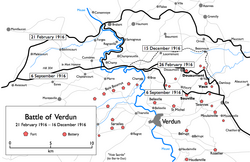| Battle of Verdun | |||||||
|---|---|---|---|---|---|---|---|
| Part of the Western Front of the First World War | |||||||
 Map of the battle | |||||||
| |||||||
| Belligerents | |||||||
|
|
| ||||||
| Commanders and leaders | |||||||
| Strength | |||||||
| c. 50 divisions | 75 divisions | ||||||
| Casualties and losses | |||||||
|
336,000–355,000 casualties
|
379,000–400,000 casualties
| ||||||
Location within France | |||||||
The Battle of Verdun (French: Bataille de Verdun [bataj də vɛʁdœ̃]; German: Schlacht um Verdun [ʃlaxt ʔʊm ˈvɛɐ̯dœ̃]) was fought from 21 February to 18 December 1916 on the Western Front in France. The battle was the longest of the First World War and took place on the hills north of Verdun-sur-Meuse. The German 5th Army attacked the defences of the Fortified Region of Verdun (RFV, Région Fortifiée de Verdun) and those of the French Second Army on the right (east) bank of the Meuse. Using the experience of the Second Battle of Champagne in 1915, the Germans planned to capture the Meuse Heights, an excellent defensive position, with good observation for artillery-fire on Verdun. The Germans hoped that the French would commit their strategic reserve to recapture the position and suffer catastrophic losses at little cost to the German infantry.
Poor weather delayed the beginning of the attack until 21 February but the Germans captured Fort Douaumont in the first three days. The advance then slowed for several days, despite inflicting many French casualties. By 6 March, 20+1⁄2 French divisions were in the RFV and a more extensive defence in depth had been organised. Philippe Pétain ordered there to be no retreat and that German attacks were to be counter-attacked, despite this exposing French infantry to the German artillery. By 29 March, French guns on the west bank had begun a constant bombardment of Germans on the east bank, causing many infantry casualties. The German offensive was extended to the west bank of the Meuse to gain observation and eliminate the French artillery firing over the river but the attacks failed to reach their objectives.
In early May, the Germans changed tactics again and made local attacks and counter-attacks; the French recaptured part of Fort Douaumont but the Germans ejected them and took many prisoners. The Germans tried alternating their attacks on either side of the Meuse and in June captured Fort Vaux. The Germans advanced towards the last geographical objectives of the original plan, at Fleury-devant-Douaumont and Fort Souville, driving a salient into the French defences. Fleury was captured and the Germans came within 2.5 mi (4 km) of the Verdun citadel but in July the offensive was limited to provide troops, artillery and ammunition for the Battle of the Somme, leading to a similar transfer of the French Tenth Army to the Somme front. From 23 June to 17 August, Fleury changed hands sixteen times and a German attack on Fort Souville failed. The offensive was reduced further but to keep French troops away from the Somme, ruses were used to disguise the change.
In September and December, French counter-offensives recaptured much ground on the east bank and recovered Fort Douaumont and Fort Vaux. The battle lasted for 302 days, one of the longest and costliest in human history. In 2000, Hannes Heer and Klaus Naumann calculated that the French suffered 377,231 casualties and the Germans 337,000, a total of 714,231 and an average of 70,000 a month. In 2014, William Philpott wrote of 714,000 casualties suffered by both sides during the Battle of Verdun in 1916 and that about 1,250,000 casualties were suffered in the vicinity of Verdun in the war. In France, the battle came to symbolise the determination of the French Army and the destructiveness of the war.
